Today we’re checking out ProjectSAM’s latest addition to their “Colours” product range: Adaptive Runs. Colours: Adaptive Runs offers a vast set of orchestral runs ranging from small intervals to multiple octaves. Its innovative programming allows you to effortlessly sync any run to your track and have it line up with your rhythmic grid which is supposed to make this library one of the most-realistic sounding out there.
We were kindly provided with a review copy of Adaptive Runs by ProjectSAM.
OVERVIEW
Colours: Adaptive Runs is a 14 GB-large sample library that features a comprehensive collection of orchestral runs. The library is designed for both the free and full version of Kontakt 6.4.2 and above. Adaptive Runs offers NKS support for all Native Instruments keyboards and control surfaces.
The entirety of samples is recorded through 4 individual microphone channels in high-quality, 48kHz/24bit resolution. Adaptive Runs was recorded in the same lush-sounding concert hall as other recent ProjectSAM libraries.
Colours: Adaptive Runs offers tempo-synced runs from various orchestral instruments and instrument groups, including strings, woodwinds, and brass. These are the combo instruments and individual instrument patches and you have access to:
| Combo Instrument Patches | Individual Instrument Patches |
| – All Strings & Winds Full Range Runs – High Strings & Winds Runs – Flutes & Piccolo Runs – High Strings & Flutes & Trumpets Runs – Low Strings & Winds Runs | – All Strings Full Range Runs – Violins Runs – Violas & Cellos Runs – All Winds Full Range Runs – Flutes Runs – Piccolo Runs – Oboes & Clarinets & Bassoons Runs – Flutes Effects Runs – Trumpets Runs – Trumpets Chromatic Runs |
ADAPTIVE SYNC
Before having a look at the library’s GUI, I’d like to kick it off by spotlighting one of the main technical innovations Adaptive Runs brings to the table: the Adaptive Sync engine.
Adaptive Sync is a smart feature that does not only adjust the tempo of a run to your host tempo, it also aligns it to the next downbeat or any custom number of beats or seconds. The engine automatically picks the best matching recording, then tweaks it further so that it hits the desired mark exactly. This means that regardless of where in a musical bar you start a run, it will always end on the next possible downbeat (if you choose so).
This virtually ends the problem of not being able to use certain tempo-sensitive sounds because they would get stretched or compressed in time too heavily, thus producing ugly artifacts. Awesome!
ADAPTIVE RUNS – GUI
Adaptive Runs was released with a streamlined interface that is going to represent the new standard for ProjectSAM’s Colours series. The large interface offers a slightly intimidating set of controls at first sight but can be grasped pretty quickly and easily once you get going.
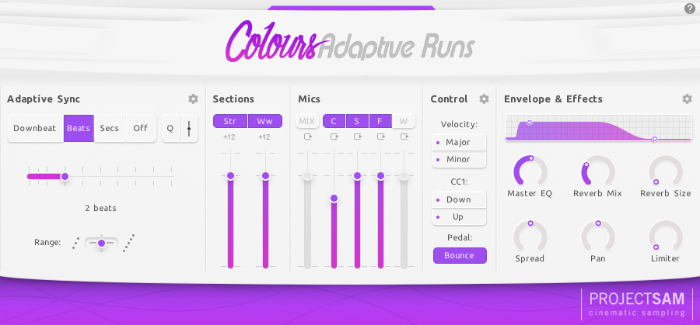
On the left, you will find all of the controls for the Adaptive Sync engine. Here, you can adjust the synchronization of sounds to either a custom length of bars, seconds, or the next downbeat. The slider below allows you to set the time frame in which the run is going to be performed. Below that, you can set the note range the run will spread across. The Range toggle lets you choose between the best-sounding run range, a narrower run range, and a wider run range. Experimenting with this range control can be quite helpful in order to find the perfect run for your arrangement.
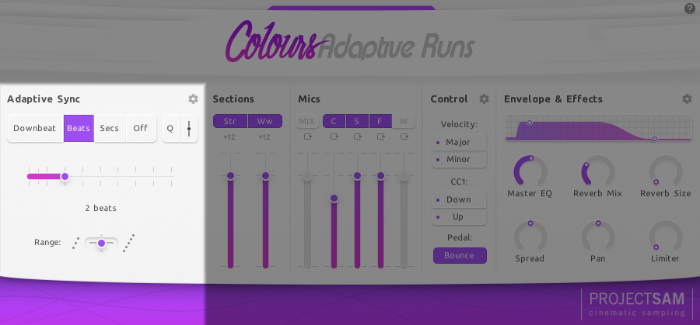
The middle section of the interface focuses on instrument sections and microphone mixes. Whenever you’re using one of the multi-instrument combo patches, the Sections window will show you volume sliders for each individual section. This way, you can change the balance of instruments or turn off individual sections if you like. A neat additional feature of the Sections panel is its Octaver function. Clicking on the little +12 icon below the instrument’s name adds another octave to the run. This is a great and quick way of making your runs cut through the mix a bit better.
The Mics section grants access to four different microphone positions (Close, Stage, Far, Wide) as well as a pre-balanced Mix setting. You can assign each microphone position to a dedicated output of Kontakt if you like, granting you the option of processing your signals “out of the box”.
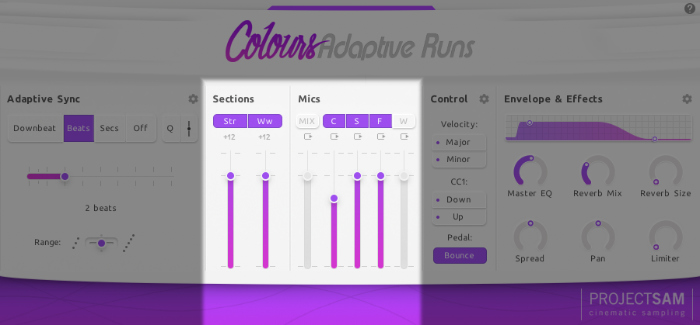
The Controls section lets you load and unload certain run directions (up/down) and scales (major/minor). By default, the direction a run goes is determined by the position of your MIDI CC01 control (usually assigned to the Mod Wheel), and the scale is determined by how hard you press your keys. This technique works very intuitively and is reliable most of the time. You can, however, change the assignment of both controls to either react to velocity, MIDI CC, or custom key switches.
Another amazing feature of the Control panel is the Bounce mode. By holding down a MIDI footswitch attached to your keyboard, you can let a run bounce up and down continuously until you let go from the pedal or note. The Bounce feature is only available for runs that cover one or more octaves.
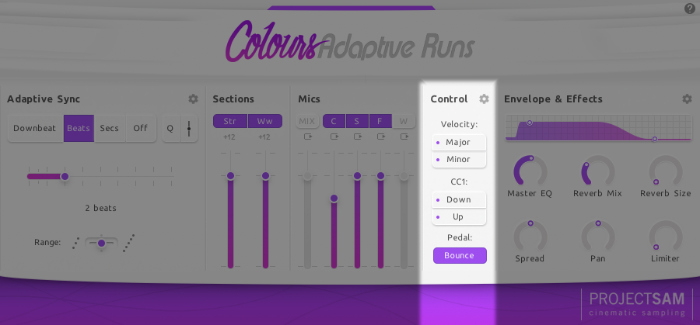
The rightmost part of the interface provides you with a selection of additional control parameters including envelope settings and effects. Adaptive Runs comes with a number of real-time effects including a digital reverb, a pre-set master EQ, a stereo imager, a pan control, and a limiter.
The Adaptive Runs interface features extensive help screens for each of the five sections of the user interface as well as useful on-screen information for most controls.
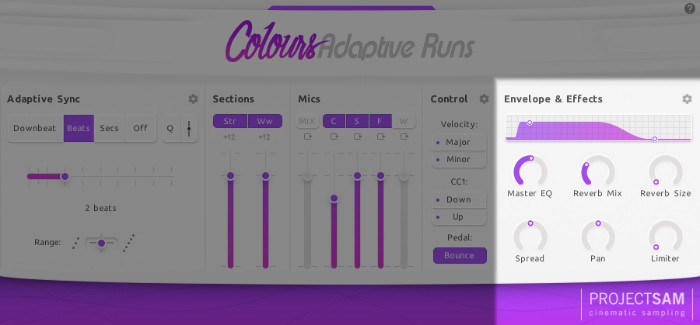
THE SOUND OF ADAPTIVE RUNS
A quick look at the sheer file size that built up from the meticulous sampling sessions shows how much really lies beneath the intuitive surface of Adaptive Runs. ProjectSAM recorded 9 different lengths of runs to choose from per note and per instrument section.
What else can I say than it shows! Through this painstaking process, it is possible to achieve alarmingly convincing, realistic results in almost every scoring situation. Playing around with the library in various music projects of mine with differing tempo and time signatures let me come to the conclusion that it’s virtually impossible to make this library sound bad.
The recording quality of the samples is on par with the high standards of ProjectSAM libraries, and the flexible microphone selection opens the door to way more applications than just orchestral scoring alone.
Although the library still retains some ambient shine from the hall when selecting the close mics only, you can perfectly set it up for a more pop-oriented, studio-type of sound. I also love how well-orchestrated the combo patches are. Their cohesive sound speeds up the usual balancing work in a mix tremendously when working on a tight deadline.
Apart from the mandatory orchestral runs in major and minor scales, Adaptive Runs also offers a couple of unique patches like the Bernard Herrmann-sy Flutes Effects Runs or the fanfare-like Trumpets Chromatic Runs. These make for great-sounding effects you can use as highlights throughout a score.
CONCLUSION
Let’s make this simple: Adaptive Runs keeps its promise of providing the smartest and most intuitive orchestral runs library out there at the moment. Although other orchestral runs libraries exist, ProjectSAM managed to fill a much-needed gap within them, coming up with the ultra-flexible Adaptive Sync engine.
The library’s sound is top-notch and has a natural but pleasantly polished sound to it which makes it a perfect fit for many different styles and genres.
If you want to come up with authentic-sounding orchestral runs quickly, intuitively and on a budget, Adaptive Runs is a sure-fire solution.
Pros
- Great-sounding orchestral runs
- Large pool of variations
- Flexible microphone options
- Intuitive user interface
- Innovative Adaptive Sync engine
Cons
- None really apart from the danger of overusing it in all of your future projects
RECOMMENDED: 10/10
Colours: Adaptive Runs is available as a download for €149 through Time+Space and ProjectSAM’s online store.


0 comments on “ProjectSAM – Colours: Adaptive Runs (Review)”